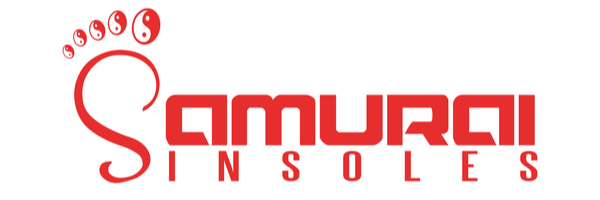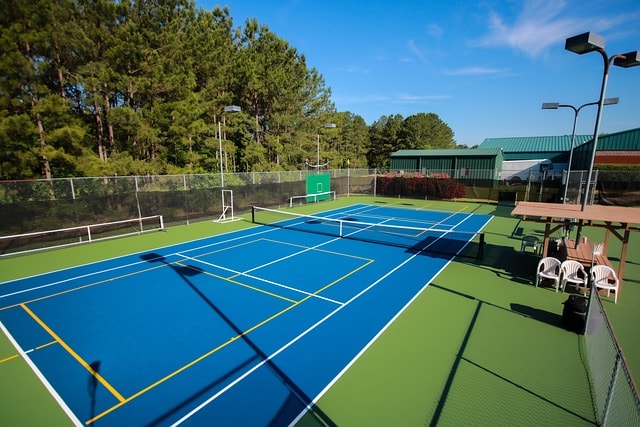Fixing overpronation isn't about one single magic bullet. It’s really a combination of strengthening the right muscles in your feet and legs, picking footwear that actually supports you, and often, using insoles to get your foot alignment back on track. When you tackle all three, you’re not just masking the pain—you’re addressing the root cause of that inward roll.
Is Your Foot Roll Causing Your Pain?
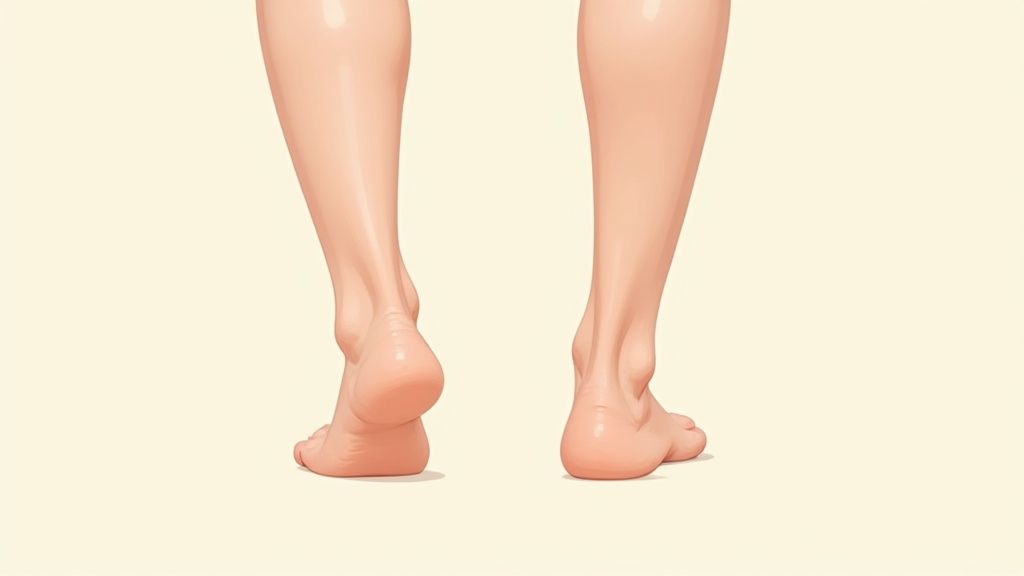
Have you ever dealt with a nagging ache in your arch? What about that mysterious knee pain that shows up after a long walk, or even a persistent twinge in your lower back? All of these issues can often be traced back to a single, common culprit: overpronation.
Overpronation is just a technical term for your foot rolling too far inward when you walk or run. A little bit of pronation is a good thing—it’s how your body naturally absorbs shock. The problem starts when there’s too much of it, which can throw your entire body's alignment out of whack.
This is an incredibly common issue. It's estimated that around 60% of adults have some degree of overpronation, which is linked to a staggering 60-90% of all biomechanical foot and lower body problems. When your foot collapses inward, it creates a chain reaction of stress that travels right up your leg. You can dive deeper into the science behind this in this detailed research on foot posture.
Recognizing the Telltale Signs
Figuring out if you overpronate is about more than just noticing you have "flat feet," even though a collapsed arch is a classic sign. The clues can be subtle and show up in places you wouldn't think to look.
Keep an eye out for these common red flags:
- Arch or Heel Pain: This is a big one. If you have constant discomfort, especially first thing in the morning or after being on your feet all day, it could be related. This is often tied to conditions like plantar fasciitis.
- Shin Splints: That excessive inward roll of your foot puts a ton of strain on the muscles along your shinbone, leading to pain.
- Knee, Hip, or Back Pain: When your feet are out of alignment, your other joints have to compensate. This often leads to chronic aches and pains further up the kinetic chain.
- Bunions or Hammertoes: Improper pressure across the front of your foot can cause or worsen these painful foot deformities.
Overpronation isn't just a "foot problem." It's a whole-body alignment issue. That pain in your knee or back might just be your body's way of telling you that your foundation is a bit shaky.
Simple At-Home Assessment Techniques
You don’t need to go to a fancy lab to get a good idea of whether you overpronate. A couple of simple checks at home can give you some surprisingly clear answers.
Here's a simple checklist you can use to assess your own feet and walking patterns. Just go through the signs and see what you notice.
Overpronation Self-Assessment Checklist
Use this checklist to identify common signs of overpronation by observing your feet and shoes.
| Symptom or Sign | What to Look For | What It Indicates |
|---|---|---|
| Footprint Shape | After wetting your foot, your footprint on paper or cardboard shows the entire sole. | A lack of a defined inner arch, suggesting a collapsed or "flat" foot. |
| Shoe Wear Pattern | The inside edge of the sole (especially at the heel and ball of the foot) is worn down. | Your foot is rolling inward excessively with each step, causing uneven wear. |
| Shoe Tilt | When placed on a flat surface, your shoes tilt inward toward each other. | The shoe's structure has been compromised by the inward pressure from your gait. |
| Arch Appearance | Your arch appears to flatten or collapse when you stand. | The arch is not providing adequate support, which is a hallmark of overpronation. |
| Ankle Roll | When viewed from behind, your Achilles tendon bows inward toward your other leg. | Your ankle joint is unstable and rolling in, a clear visual sign of overpronation. |
This checklist isn't a formal diagnosis, but if you're ticking off a few of these boxes, it’s a strong signal that overpronation could be contributing to your discomfort. Seeing these patterns for yourself is the first real step toward finding a solution that works for you.
Build a Stronger Foundation with Targeted Exercises
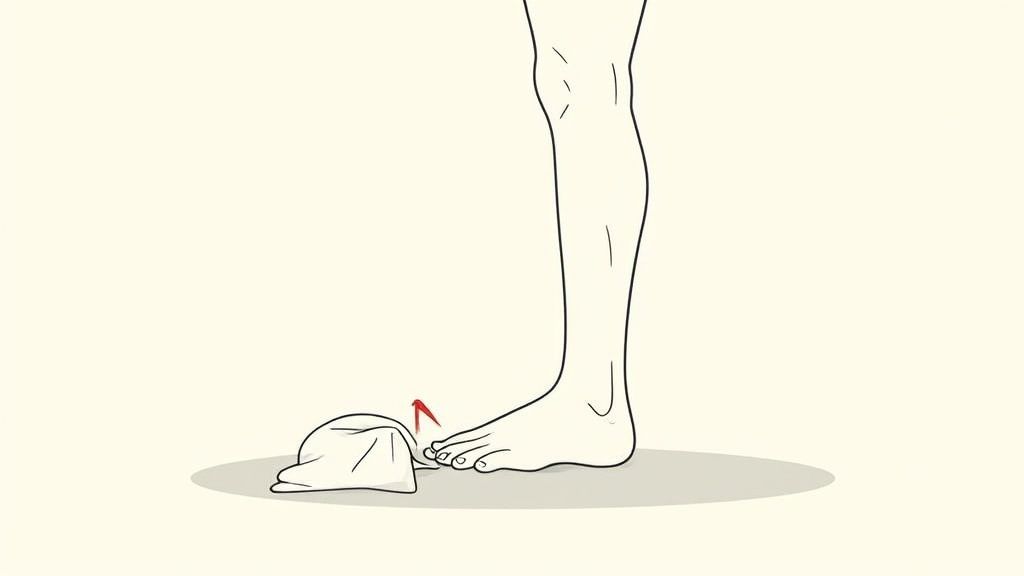
Supportive shoes and good insoles are great for providing outside help, but for real, lasting relief from overpronation, you have to build strength from the inside out. I always tell people to think of their feet as the foundation of their house. A weak foundation makes the whole structure unstable, and it’s the same with your body.
The idea isn't just to work your feet, but to wake up and strengthen the specific muscles that have gotten lazy and allowed your arch to collapse. We're talking about the tiny intrinsic muscles inside the foot and, critically, the posterior tibial tendon. This tendon is your body's natural arch support sling. A strong one actively holds the arch up and fights that inward roll.
Exercises to Rebuild Your Arch Support
Consistency is everything. You won't see a dramatic change overnight, but if you stick with these exercises three or four times a week, you'll gradually build the muscle endurance your feet need to support you properly.
Towel Curls
This is a classic for a reason. It’s fantastic for firing up the small muscles in your feet that often go dormant when you overpronate.
- How to do it: Sit in a chair, feet flat on the floor. Place a small hand towel in front of you. Using only your toes, start scrunching the towel to pull it towards you.
- Pro Tip: Try to keep your heel and the ball of your foot glued to the floor. All the work should come from your toes.
- Reps: Do this 5-10 times with each foot.
Calf Raises with an Arch Lift
Here, we’re taking a standard calf raise and adding a very specific focus. This directly trains your foot to resist collapsing inward as you move.
- How to do it: Stand with your feet about hip-width apart. As you rise onto the balls of your feet, really focus on lifting your arches and putting your weight slightly more towards the outside edges of your feet.
- Pro Tip: It's easy to let your ankles roll out too far. The goal is to feel the muscles on the inside of your lower leg and arch engage, not to wobble.
- Reps: Hold the top position for two seconds, then lower down slowly. Aim for 2-3 sets of 15-20 reps.
Remember, you're retraining muscle memory. You are teaching your foot how to hold itself in a stable, correct position, which will make you less reliant on external supports over time.
Enhancing Stability and Balance
Overpronation isn't just an arch problem; it throws off your entire sense of balance and ankle stability. These next exercises force your body to stay aligned from the ground up, which is crucial for fixing your gait.
Single-Leg Balance
Simple but incredibly effective. This move sharpens your body's awareness of where it is in space (proprioception) and strengthens all the little stabilizing muscles around your ankle.
- Stand on one leg with a soft, slight bend in your standing knee.
- Concentrate on keeping your arch from dropping and your ankle from caving in.
- Hold for 30 seconds. If that feels too easy, try closing your eyes to really test your stability.
- Switch legs and repeat. Aim for 3-4 holds on each side.
If you're looking to build out a more complete routine, you can find more ideas in our guide to the best foot pronation exercises, which has other great techniques to add to your program.
A Note on Stretching
Strengthening is the priority, but don't forget to stretch. Tight calf muscles and a tight Achilles tendon can pull on your heel and make overpronation worse.
A simple heel stretch against a wall can make a huge difference. Face a wall, step one foot forward with a bent knee, and keep the back leg straight with your heel planted firmly on the floor. Lean in until you feel a good, gentle stretch in the calf of your back leg. Hold for 30 seconds, then switch sides.
By combining these targeted exercises, you're attacking overpronation from the inside out, building a much stronger and more reliable foundation for every step you take.
Choose the Right Shoes for Overpronation
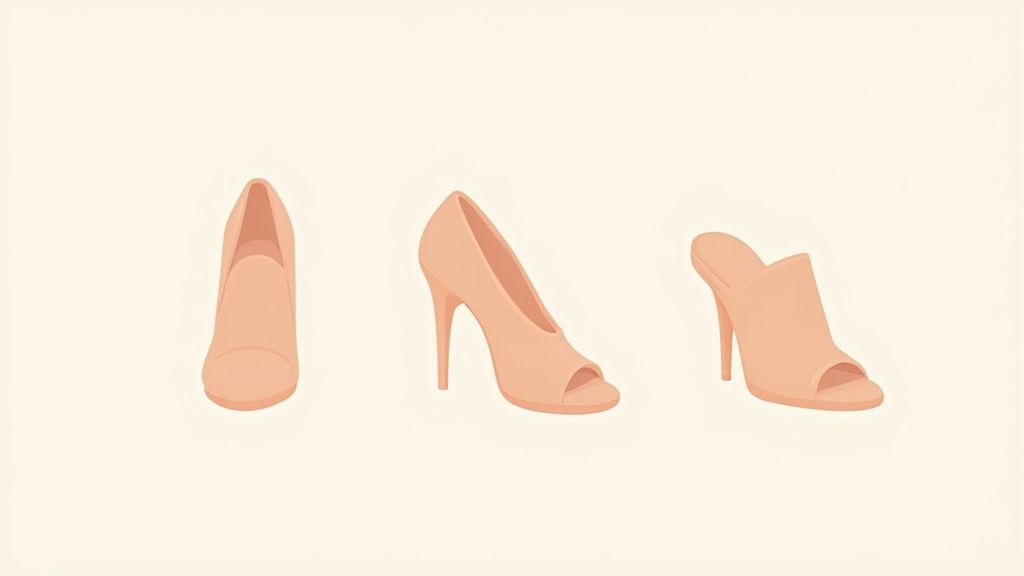
While strengthening your feet from the inside out is essential, your shoes provide the critical external support you need every single day. In fact, choosing the right footwear is probably the quickest and most effective way to start managing your overpronation.
Think about it: your shoes can either fight against your foot's tendency to roll inward or, unfortunately, make it much worse.
A flimsy, overly flexible shoe is like trying to hammer a nail with a pool noodle—it just won't work. But a shoe with the right kind of structure acts as a stable platform, guiding your foot into a more neutral position with every step. This simple change can make a world of difference for the strain on your feet, ankles, and even your knees.
Understanding Shoe Categories
Walk into any running or shoe store, and you’ll see shoes organized into a few main categories. Knowing what they mean is your first step to finding the right pair.
-
Neutral Shoes: These are all about maximum cushion with minimal structural support. They’re built for people with a neutral gait or those who supinate (roll outward). For anyone with overpronation, these shoes usually lack the stability needed to keep the arch from collapsing.
-
Stability Shoes: For most people dealing with mild to moderate overpronation, this is the sweet spot. Stability shoes offer a great blend of cushioning and support features, like firmer foam along the inside of the midsole. This gently guides the foot and prevents it from rolling in too far.
-
Motion Control Shoes: These are the heavy-duty option. Designed for more severe overpronation or very flat feet, motion control shoes are more rigid and packed with tech to limit unwanted movement. They offer maximum stability, but can feel pretty stiff if you don't truly need that level of correction.
For most people looking at how to fix overpronation, stability shoes are the perfect balance of support and comfort for daily life and exercise.
Your footwear is your first line of defense. The right shoe works with your foot to create a more stable, aligned foundation, reducing stress not just on your arch but on your entire body.
What to Look for in a Supportive Shoe
You don't need to be a footwear engineer to pick a good shoe. You just need to know what to look for and how to do a couple of quick tests right in the store.
Here are the key features that make a shoe great for battling overpronation.
Firm Heel Counter
This is non-negotiable. The heel counter is the small plastic insert that gives the back of the shoe its shape.
- What it does: A firm one cups your heel securely, preventing it from wiggling around. This reduces the side-to-side sloppiness that lets overpronation run wild.
- How to test it: Give the back of the shoe a good squeeze with your thumb. It should feel stiff and shouldn't collapse easily.
Medial Post Support
This is the secret sauce in most stability shoes. It's simply a section of denser, firmer foam built into the inside (medial) part of the midsole, right under your arch.
- What it does: Because this foam is firmer, it doesn't compress as much when you put weight on it. This props up the arch and slows down that inward roll.
- How to spot it: It often looks like a gray-colored, speckled block of foam on the inner arch side of the shoe's sole.
A Rigid Midfoot
A shoe that twists like a wet rag in the middle isn't going to give you any real support.
- How to test it: Grab the shoe by the heel and the toe and try to twist it. A good stability shoe will resist twisting. It should only bend where your foot naturally bends—at the ball of the foot.
Practical Tips for Shoe Shopping
Being a smart shopper can save you a lot of pain later. Don't just grab the first pair that catches your eye; put them through their paces.
| Shopping Tip | Why It Matters |
|---|---|
| Shop in the Afternoon or Evening | Your feet naturally swell during the day. Shopping later ensures you get a size that will still be comfortable when they're at their largest. |
| Wear Your Usual Socks | Bring the socks you actually wear (e.g., your running socks for running shoes) to get the most accurate fit possible. |
| Test Both Shoes | Most of us have one foot that's slightly bigger than the other. Always try on both shoes and take a walk around the store for a few minutes. |
| Check the Insole | Pull out the factory insole. Does it come out easily? This is critical if you plan on using your own orthotics or a more supportive over-the-counter insole. |
By keeping an eye on these features and testing shoes the right way, you can find footwear that actively helps your gait instead of just covering your feet.
Use Insoles And Orthotics For Foot Correction
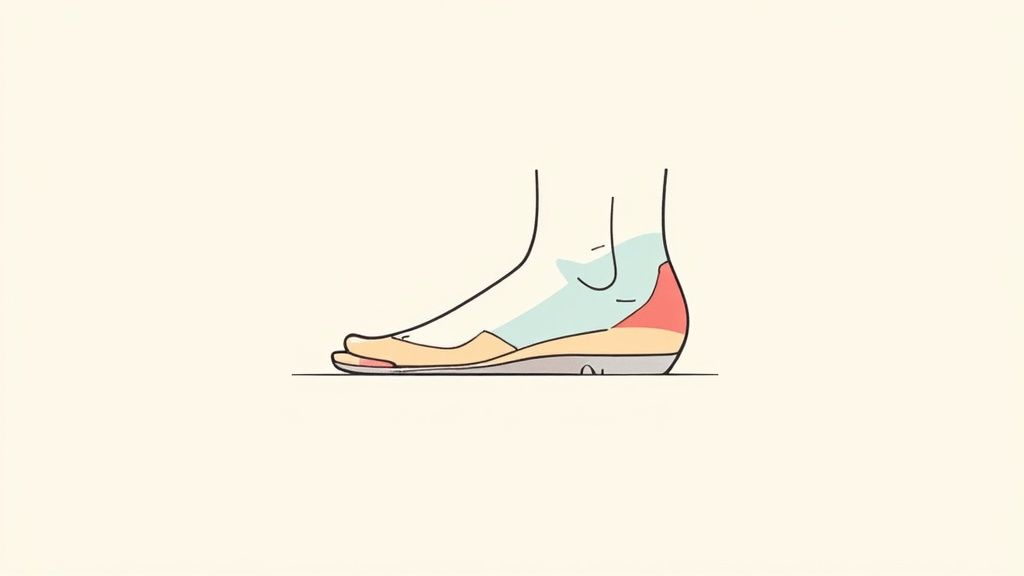
While targeted exercises and the right shoes are foundational, sometimes you need a more direct approach. That's where insoles and orthotics come in. They are often the quickest way to get relief and start correcting your foot alignment.
Think of them as a support system that gets to work the moment you slide them into your shoes. They guide your foot into a healthier, more neutral position with every step, which can make a world of difference. This isn't just about your feet, either—it helps realign your knees, hips, and back, too.
Over-the-Counter Insoles: A Great Place to Start
For most people, over-the-counter (OTC) insoles are the logical first step. They're easy to find everywhere from your local pharmacy to online stores, and they offer a practical solution for mild to moderate overpronation without breaking the bank.
These insoles are designed for general foot shapes, so while they aren't custom-made, a good pair will offer a noticeable boost in arch support and comfort. I often recommend them to people who have decent shoes but find the flimsy factory insoles just aren't cutting it.
When To Consider Custom Orthotics
So, when does it make sense to level up to custom orthotics?
If your overpronation is severe, you're dealing with persistent pain despite trying other solutions, or you have a structural issue like very flat feet, it's probably time to see a podiatrist.
Custom orthotics are true medical devices. A foot specialist takes a precise 3D scan or mold of your feet to create an orthotic that corrects your specific biomechanical quirks. This isn't just general support; it's a personalized prescription for your feet. This level of precision is critical for some, especially when dealing with issues like flat feet, which affects a surprising number of people. In fact, some studies show a prevalence of around 13.6% in young adults.
The biggest difference is simple: over-the-counter insoles provide general support for a foot type, while custom orthotics provide precise correction for your foot.
Deciding between them usually comes down to the severity of your pronation, your pain level, and your budget. This table should help clarify things.
Over-the-Counter Insoles vs. Custom Orthotics
Here’s a comparison to help you decide which type of foot support is best for your needs and budget.
| Feature | Over-the-Counter Insoles | Custom Orthotics |
|---|---|---|
| Correction | Provides general arch support and cushioning. | Offers precise, individualized biomechanical correction. |
| Cost | Typically affordable, ranging from $20 to $80. | More expensive, often costing $300 to $800+. |
| Accessibility | Widely available in stores and online, no prescription needed. | Requires a podiatrist visit for molding and fitting. |
| Durability | Generally lasts 6-12 months with regular use. | Can last for several years with proper care. |
| Best For | Mild to moderate overpronation and general foot fatigue. | Severe overpronation, chronic pain, or structural issues. |
Ultimately, both options have the same goal: realigning your foot to reduce overpronation. Starting with an OTC insole is a low-risk way to see if orthotic support helps you. If you get some relief but feel you need more, it's a good indicator that investing in a custom pair would be money well spent.
For a deeper look into how these tools work, check out our complete guide on using orthotics for foot pronation.
When It's Time to See a Professional for Your Foot Pain
Building strength and picking the right shoes and insoles are fantastic first steps for tackling overpronation. But sometimes, they're just not enough. Self-care has its limits, and knowing when to call in an expert is crucial for stopping a nagging issue from becoming a chronic, life-altering problem.
Maybe you've tried everything. You bought the stability shoes, you've been doing your exercises religiously, but the pain just isn't letting up. If weeks have turned into months and you're still wincing with every step, it’s time to stop guessing. This is one of the clearest signs you need a formal diagnosis from a professional like a podiatrist or physical therapist.
Red Flags You Shouldn't Ignore
Certain symptoms are more than just typical aches and pains—they're your body's alarm system screaming that something more serious might be going on. Don't try to be a hero and push through these.
Be on the lookout for these warning signs:
- Persistent Pain: If foot, ankle, or knee pain sticks around for more than a few weeks or actually gets worse despite your efforts, that’s your cue to see a specialist.
- Numbness or Tingling: That "pins and needles" sensation or any loss of feeling in your feet is never normal. This warrants immediate medical attention.
- Difficulty with Daily Activities: Is your foot pain stopping you from walking comfortably, standing at work, or enjoying your favorite hobbies? Professional help is no longer optional.
- A Visible Deformity: If you notice a real change in your foot's shape, like a bunion that’s getting worse or an arch that looks like it has completely collapsed, an expert needs to take a look.
- Underlying Health Conditions: For anyone with diabetes, arthritis, or circulatory issues, foot problems should always be managed with a doctor's supervision.
Don't fall into the trap of thinking you just have to "live with it." Persistent foot pain isn't a normal part of life or getting older. A professional can offer solutions you probably never even knew existed.
What a Specialist Can Do for You
A podiatrist or physical therapist brings a whole new level of diagnostic tools and treatments to the table, far beyond what you can do at home. They can perform a thorough biomechanical evaluation to get to the root cause of your pain.
For example, they might perform a formal gait analysis, which gives a super-detailed breakdown of how your feet and legs move when you walk. This kind of professional analysis can spot subtle imbalances that a simple at-home check will almost certainly miss.
It's also worth noting that your biology can play a role. Epidemiological research has found that pronated feet are significantly more common in young women (35.6%) than in men (11.3%). This difference is often tied to factors like greater joint laxity in females. It's a perfect example of why a one-size-fits-all approach often fails, and it’s exactly the kind of nuance a specialist is trained to address. You can even read the full research about these gender differences if you're curious.
In the end, seeing a professional isn't giving up—it's taking control. It’s an investment in your own health that can save you from years of needless pain and get you back to moving with comfort and confidence.
Still Have Questions About Overpronation?
It's totally normal if you've still got a few things on your mind after learning about exercises, shoes, and insoles. In my experience, digging into the details is what gives people the confidence to actually stick with a plan and get the relief they're looking for.
Let’s tackle some of the most common questions I hear. Getting clear, straightforward answers can be the difference between feeling overwhelmed and feeling ready to take control.
Can I Fix Overpronation for Good?
This is the big one, and the honest answer means we need to think about it less as a "cure" and more as smart "management." For most people, overpronation is a structural thing you’re born with, like your eye color. It's part of your unique biomechanics, not a sickness you can just get rid of.
But that absolutely does not mean you're stuck with pain. You can manage it so well that it becomes a non-issue in your daily life. I like to compare it to needing glasses. The glasses don't cure your eyesight, but they correct it perfectly so you can see clearly.
The goal isn't a magical, one-time fix. It's about consistent, effective management that lets you live pain-free.
When you combine targeted strengthening exercises, the right stability shoes, and a good pair of orthotic insoles, you're actively correcting your foot's alignment with every step. This approach gets to the root of the problem, offering lasting relief and preventing new injuries down the road. The real secret? Sticking with it.
How Long Does It Take to Feel a Difference?
While patience is definitely a virtue here, you’ll be happy to know some relief can come surprisingly fast. The moment you slide your foot into a proper stability shoe or add a supportive insole, you’re changing the game. That external support gives you an immediate lift, taking strain off your arches and tendons right out of the box.
For the exercises, the timeline is a bit longer because you’re actually building new muscle and teaching your body new habits.
Here's what you can realistically expect:
- Immediate Relief (The First Week): Just by upgrading your footwear or popping in some insoles, you should feel a noticeable difference in comfort.
- Feeling More Stable (4-6 Weeks): If you're doing your exercises consistently (3-4 times a week), you'll start to feel a new sense of stability in your feet and ankles. You might notice you can stand longer without that achy, tired feeling in your arches.
- Real, Lasting Improvement (2-3 Months): This is where the hard work really pays off. After a couple of months, you should see a major drop in pain and a clear improvement in how you walk.
Is Walking Barefoot a Bad Idea?
This is a tricky one, and the answer is a classic: it depends. There’s a popular school of thought that barefoot walking strengthens your feet, and for some, that's true. Short walks on soft, uneven surfaces like grass or sand can wake up the little muscles in your feet and get them firing.
However, for someone with significant overpronation, walking barefoot on hard floors—like concrete, tile, or hardwood—can be a disaster waiting to happen.
Without any support, your arch is free to completely collapse with every single step. This puts a ton of strain on your plantar fascia and posterior tibial tendon, which can make your pain and your overpronation even worse. It’s like asking a strained muscle to lift something heavy; it’s just not ready for that kind of load.
My two cents:
- Build a Foundation First: Start by getting strong with your exercises while using supportive shoes and insoles.
- Introduce Barefoot Time Slowly: If you want to try it, start with just a few minutes a day on a soft surface like a plush carpet or lawn.
- Listen to Your Body: If you feel any twinge of pain, stop. That's your body's way of saying it’s not ready.
It’s always smarter to build up your foot's internal strength before you take away its external support system.
Can Overpronation Cause Problems in Other Parts of My Body?
Absolutely. And honestly, this is something that can’t be stressed enough. Overpronation sets off a chain reaction of misalignment that travels right up your body, causing trouble in places you’d never think to connect to your feet.
Imagine your body is a tower of building blocks. If the foundation is crooked, the whole structure becomes wobbly.
- Ankles and Shins: As your foot rolls inward, it puts a ton of stress on your ankle and can cause your lower leg bone (the tibia) to rotate. This is a classic recipe for shin splints.
- Knees: That same inward rotation throws your knee joint out of whack. It’s one of the most common causes of runner's knee (patellofemoral pain), where you get that nagging ache right under your kneecap.
- Hips and Back: The misalignment doesn't stop there. Your hips might tilt to compensate, leading to hip pain or bursitis. From there, the tilt can mess with your pelvis and sacroiliac (SI) joints, resulting in stubborn, chronic lower back pain.
Fixing overpronation isn't just about your feet. It's about restoring balance and health to your entire body, starting from the ground up.
Ready to stop that chain reaction of pain and give your feet the rock-solid support they need? Samurai Insoles were designed by a foot doctor specifically to tackle overpronation where it starts. Our insoles deliver the perfect blend of support and comfort to realign your foundation, bringing relief not just to your feet, but to your knees and back, too. Stop guessing and start feeling better with every single step. Try them risk-free at https://samuraiinsoles.com.
